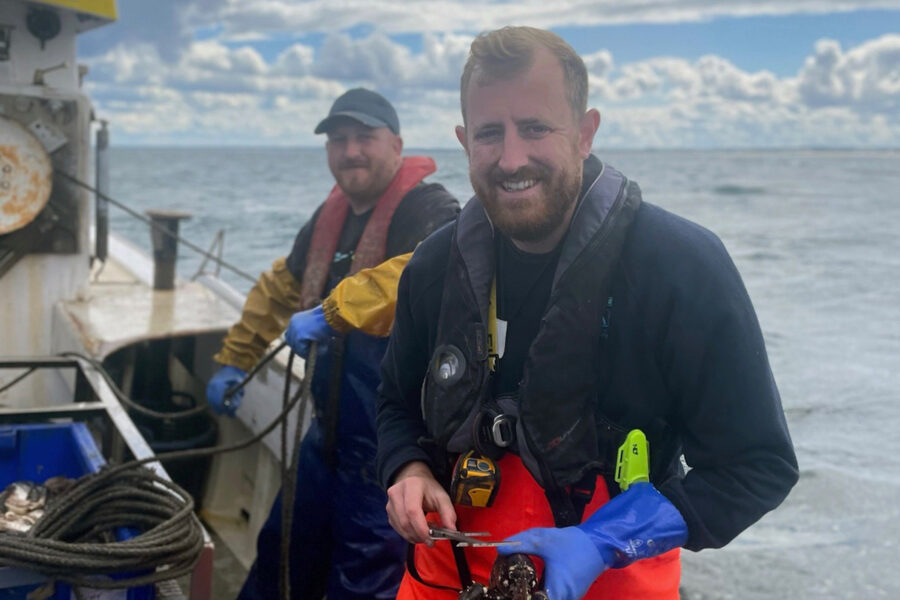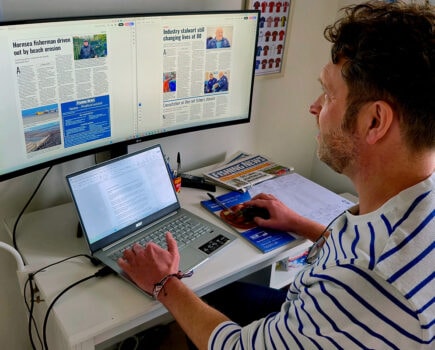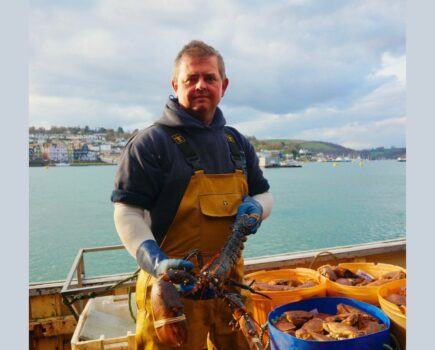Share a day in the life of NIFCA environmental inshore fisheries and conservation officer, Andrew Boon…
“From a very young age, probably six or seven years old, I’ve always had a fascination with the sea. One day I turned round to my parents and said: ‘I want to be a marine biologist’ – and that was the start of it really,” Andrew Boon, the senior environmental inshore fisheries and conservation officer at Northumberland Inshore Fisheries and Conservation Authority (NIFCA), told Fishing News.
“I went through school knowing what I wanted to do, and then went to the University of Hull at its Scarborough campus to study coastal marine biology. I moved back home to study my master’s degree at Newcastle University before I started a role working for North Eastern IFCA.”
Fifteen months later, Andrew was offered an opportunity at NIFCA. “I joined on a research contract basis doing an assessment on brown crab stocks in the Northumberland district.
“Following the end of my research contract, the opportunity was there to stay on as an environmental officer. I’ve been here four and half years, and now I’m the senior environmental officer sitting below our lead environmental officer in the team – which is just about to go up to five in number.”
Andrew leads on the district’s crustacea and monitoring work. “Our primary fishery is static gear for lobster and crab – that’s our bread and butter really. There is some trawling for Nephrops as well, although most of it is just outside of the district.”
Andrew and the rest of the team sample both shore-based landed catch throughout the district’s ports and harbours, and offshore – which can involve days at sea onboard fishing vessels.
“We’ll essentially measure whatever the fishermen catch for the day – that’s year-round, from the very glamorous side in the summer all the way through to the less glamorous wintery days that you can find yourself in.”
Andrew, along with long- serving NIFCA chief officer Mark Southerton and his team, is a familiar face along the Northumberland coastline, which Andrew says helps to build relationships.

“I’ve never wanted to make decisions that would affect people without understanding how the job works,” said Andrew. “I’m by no means a commercial fisherman, but I’ve spent plenty of hours on a fishing boat and seen the problems they face first-hand. I think we get a bit of respect from the industry for going out with them, and we’ve built some great relationships with the local industry.”
“We’ve developed a really good relationship with the local industry, which works brilliantly for us. It’s the same with the guys when they let us come out with them. Obviously, we are an unfamiliar body on their boat. We’re always going to get in the way in some form or another, so we try to make ourselves as inconspicuous as possible.
“It is extremely valuable for us to be out with local fishers on their boats and seeing what they do. I like to think that any decision that we make as an IFCA is based on us knowing quite a bit about what the job itself entails.”
In addition to sampling, Andrew’s responsibilities can also include marine licensing and planning tasks, as well as writing and reviewing byelaws.
“My job is so varied. I can go through a few weeks where I’m office-based attending meetings and carrying out administrative duties, whereas other times it feels like I’m never in the office.
“A typical week might involve a day at sea on a fishing boat, shore-based work, or a day on one of our patrol vessels, followed by the unenviable task of data entry and Excel sheets.”
It might be a less exciting part of the role, but data inputting is an important step in the process – for the authority, the fishery and the local industry.
“We’ve got data going back to 2012 for lobster with more than 35,000 measurements recorded – so we have a substantial dataset. That gives us a real understanding of the fishery and local population. We also monitor landings through our permit returns to give us a useful insight into any trends.
“We’ve built up a good idea of the local population through our work, and by going offshore we get to see all the unlanded catch, whether it be small, berried or V-notched.
“That all feeds into a better understanding of the fishery as a whole. So when we’re faced with things like the current Fisheries Management Plan consultation for crab and lobster, that data feeds directly into how we will respond to any proposed management.”

Andrew at his desk. The authority has built up a ‘significant dataset’ from offshore and onshore sampling. “Ultimately, we’re doing this for the industry and for the marine environment that we have in Northumberland, to give it the best chance and best representation when it comes to things like FMP consultations.”
The data can also back up what fishermen say they are seeing on the grounds, which can help shape major management decisions, as in the case of the successful opposition to the proposed Lindisfarne HPMA.
Inevitably, there are also times when the data disagrees with what’s being reported from the grounds. “We’ve had plenty of debates with fishermen about what our data shows compared to what they are seeing – but we’re able to tell them about the scale of the data we have, and how many years we’ve been collecting it. We may agree to disagree on some aspects, but they understand where we’re coming from, and we understand where they’re coming from.
“I think it’s the classic thing that the fisheries authorities are never going to agree with what fishermen are saying all of the time, and vice versa – but there’s always going to be areas of commonality,” said Andrew.
“It’s all about mutual understanding and respect. We’ve got a job to do at the end of the day – as much as the fishermen have too.”
This story was taken from the latest issue of Fishing News. For more up-to-date and in-depth reports on the UK and Irish commercial fishing sector, subscribe to Fishing News here or buy the latest single issue for just £3.50 here.
Sign up to Fishing News’ FREE e-newsletter here.







